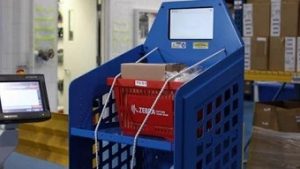
The COVID-19 outbreak has brought new realities to light that, just a few months ago, seemed unimaginable. Stay-at-home orders are keeping many people close to home. And social distancing – along with frequent cleaning of technology devices, hands and surfaces – is widely accepted as the new norm.
Front-line workers in healthcare, public safety, retail, manufacturing and transportation & logistics have found it particularly challenging to maintain a three or six-foot separation from other people while maintaining essential services. Medical treatments and those producing, picking, packing and delivering goods to maintain supply chain continuity will – at some point – come into close contact with others. Despite best efforts, there are just some scenarios in which it is impossible to fully comply with social distancing recommendations.
That being said, we are quickly discovering many instances in which technology can help workers and their customers minimize close-contact scenarios, if not eliminate them all together. Shohail Ahmed, a Senior Engineering Manager for Zebra Technologies, gives a breakdown of a few of those instances here.
Artificial Intelligence (AI)
Traditionally, patient triage and initial diagnostics have been conducted in person by healthcare team members. Now, some are being done online or over the phone with a list of pre-identified questions to minimize the risk of potential contagion exposure to other patients and clinicians. This new practice has proved valuable from a social distancing perspective, but has not yet been implemented at the level required to be highly effective or efficient from an operational perspective given the labour resources required to virtually screen patients. Instead, AI could be used to conduct the initial screening of patients without human interface and likewise guide patients to the right direction based on the severity of their conditions. In-person diagnosis should only be conducted if deemed necessary. AI can gain info, process it and provide the output to the patients and care team members via machine learning algorithms. The right combination of AI and predictive analytics technologies can also assist in optimising hospitals’ operating efficiencies, increasing asset utilisation and maintaining required equipment disinfection.
Internet Of Things (IOT)
IoT-enabled thermometers could potentially be used to take patients’ temperatures from a distance. Similarly, patients can take their own temperatures and upload their data via mobile devices for virtual monitoring by their care team. This enables healthcare providers to efficiently collect more data while reducing their risk of getting exposed – or exposing their patients – to contagions.
IoT-connected sensors can also prove valuable in healthcare, as well as retail, to alert people when they are not maintaining the mandated physical distance when standing in lines. Likewise, this solution can make a difference for public transportation systems seeking to maintain a certain physical distance between vehicle operators and among passengers. Manufacturing and e-commerce fulfillment environments can also use sensors to maintain physical distancing between workers and/or co-bots.
5G
Real-time data is essential to tracking both people and assets, either to monitor compliance with stay-at-home orders or the current location of essential supplies and equipment. 5G provides the network bandwidth needed to expand such track-and-trace capabilities.
Barcode Scanners
Extended range scanners, in particular, allow front-line healthcare and public safety teams to scan barcodes on citizen ID cards while maintaining required physical distancing.
Co-Bots and similar intelligent automation solutions
There is a strong case for smart robotics solutions in warehousing and retail environments right now. Employing co-bots to retrieve picked items and transport them to packing stations can reduce warehouse workers’ movements and interactions. And mobile automation solutions that roam grocery store aisles to check for out-of-stock or misplaced items can minimize the number of associates that have to be on the floor. Of course, intelligent automation solutions could be used to deliver essentials, such as food and medicine, to customers and patients as well.
In healthcare environments, smart robots could potentially be used to take patients’ temperatures in lieu of other IoT technologies. Co-bots could also be used to transport COVID-19 samples from the point of collection to the lab to reduce unnecessary walking by care team members and maintain social distancing. Similar technologies are already in use in some hospitals to remotely monitor patients and reduce close contact for nurses and doctors.
Kiosks
Self-checkout kiosks are another way of maintaining physical distancing between customers and associates in retail environments. There are many more ways in which technologies which were once considered “good to have” can now be highly-effective game changers in the fight against COVID-19.











